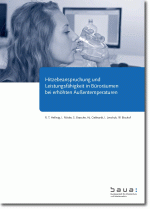Recommendations for a safe, healthy climate at work
A workplace climate adapted to workers’ needs will have sustainable, positive effects on their health, performance, satisfaction, and well-being. Climate conditions that are too hot or too cold can cause damage to individuals' health.

Employees are exposed to various physical factors in the workplace. These pages provide information for employers and employees about requirements concerning the workplace climate, the legal situation, and the protective measures that can be taken in response to particular climate conditions.
The air temperatures in workplaces such as offices, retail units, and workshops can rise to detrimental levels in summer, causing employees to suffer from the heat. The consequences of high temperatures in the workplace range from deteriorating performance, declining motivation, fatigue, and poor concentration to increased perspiration and strains on the cardiovascular system. Studies have also demonstrated a noticeably raised risk of accidents occurring when indoor air temperatures are too high.






